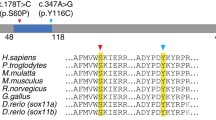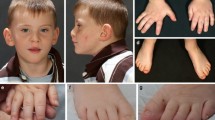Abstract
Bohring-Opitz syndrome is characterized by severe intellectual disability, distinctive facial features and multiple congenital malformations. We sequenced the exomes of three individuals with Bohring-Opitz syndrome and in each identified heterozygous de novo nonsense mutations in ASXL1, which is required for maintenance of both activation and silencing of Hox genes. In total, 7 out of 13 subjects with a Bohring-Opitz phenotype had de novo ASXL1 mutations, suggesting that the syndrome is genetically heterogeneous.

Similar content being viewed by others
Accession codes
References
Oberklaid, F. & Danks, D.M. Am. J. Dis. Child. 129, 1348–1349 (1975).
Hastings, R., Cobben, J.M. & Gillessen-Kaesbach, G. et al. Eur. J. Hum. Genet. 19, 513–519 (2011).
Bohring, A., Oudesluijs, G.G., Grange, D.K., Zampino, G. & Thierry, P. Am. J. Med. Genet. A. 140, 1257–1263 (2006).
Ng, S.B. et al. Nat. Genet. 42, 790–793 (2010).
Gilissen, C. et al. Am. J. Hum. Genet. 87, 418–423 (2010).
Hoischen, A. et al. Nat. Genet. 42, 483–485 (2010).
Kaname, T. et al. Am. J. Hum. Genet. 81, 835–841 (2007).
Bisgaard, A.M. et al. Eur. J. Med. Genet. 50, 243–255 (2007).
Fisher, C.L. et al. Dev. Biol. 337, 9–15 (2010).
Kleefstra, T., Nillesen, W.M. & Yntema, H.G. GeneReviews (eds Pagon, R.A., Bird, T.D., Dolan, C.R. & Stephens, K.) (University of Washington, Seattle, Washington, USA, 1993–2010 ).
Gelsi-Boyer, V. et al. Br. J. Haematol. 151, 365–375 (2010).
Boultwood, J. et al. Leukemia 24, 1062–1065 (2010).
Bench, A.J. et al. Oncogene 19, 3902–3913 (2000).
Rodríguez-Santiago, B. et al. Am. J. Hum. Genet. 87, 129–138 (2010).
Acknowledgements
We thank the subjects and their parents for participation in this study. We thank P. Arts, M. Steehouwer and personnel from the Microarray Facility and Sequencing Facility Nijmegen for technical assistance. We thank N. Wieskamp, J. de Ligt and M. Rosario for bioinformatics support in data analysis. The authors are grateful to M. Sipponen and J. Ignatius for collaborative efforts relating to patient 4 and to C. Fisher for information on the Asxl1 knockout mouse. This study was financially supported by the Netherlands Organization for Health Research and Development (ZonMW grants 917-66-36 and 911-08-025 to J.A.V., 916-86-016 to L.E.L.M.V. and 917-86-319 to B.B.B.A.d.V.), the EU-funded TECHGENE project (Health-F5-2009-223143 to J.A.V.) and the AnEUploidy project (LSHG-CT-2006-37627 to A.H., B.W.M.v.B., H.G.B., B.B.B.A.d.V. and J.A.V.). The Family Federation of Finland is funded by Finland's Slot Machine Association (RAY). B. R.-S. was supported by a postdoctoral fellowship of the Fondo Investigación Sanitaria, Spain (FIS CD06/00019).
Author information
Authors and Affiliations
Contributions
A.H., B.W.M.v.B., B.R.-S., H.G.B., B.B.B.A.d.V. and J.A.V. conceived the project and planned the experiments. B.W.M.v.B., H.G.B. and B.B.B.A.d.V. performed review of phenotypes and sample collection. H.G.B., R.H., S.F.S., R.N.-E., S.K., J.G., R.M., D.B., A.R., M.P., J.M.C., D.W. and G.G.-K. clinically characterized the Bohring-Opitz syndrome cases and collected blood samples. A.H., L.E.L.M.V., P.d.V., I.J. and B.v.L. performed next-generation sequencing experiments. P.d.V. and B.v.L. performed validation experiments. C.G., B.R.-S. and A.H. analyzed and interpreted the data. All authors contributed to the final manuscript.
Corresponding author
Ethics declarations
Competing interests
The authors declare no competing financial interests.
Supplementary information
Supplementary Text and Figures
Supplementary Tables 1–3, Supplementary Figures 1 and 2 and Supplementary Note. (PDF 1080 kb)
Rights and permissions
About this article
Cite this article
Hoischen, A., van Bon, B., Rodríguez-Santiago, B. et al. De novo nonsense mutations in ASXL1 cause Bohring-Opitz syndrome. Nat Genet 43, 729–731 (2011). https://doi.org/10.1038/ng.868
Received:
Accepted:
Published:
Issue Date:
DOI: https://doi.org/10.1038/ng.868
- Springer Nature America, Inc.
This article is cited by
-
H2A monoubiquitination: insights from human genetics and animal models
Human Genetics (2023)
-
Epigenetic regulation by ASXL1 in myeloid malignancies
International Journal of Hematology (2023)
-
DNA methylation signature associated with Bohring-Opitz syndrome: a new tool for functional classification of variants in ASXL genes
European Journal of Human Genetics (2022)
-
Germline Abnormalities in DNA Methylation and Histone Modification and Associated Cancer Risk
Current Hematologic Malignancy Reports (2022)
-
Perithyroidal Salivary Gland Acinic Cell Carcinoma: Morphological and Molecular Attributes of a Unique Lesion
Head and Neck Pathology (2021)





